Trazodone is a medication commonly used in cats to alleviate anxiety and stress, particularly during stressful events. It operates as a serotonin antagonist/reuptake inhibitor. Typically administered as needed or every 12 hours, the dosage is carefully determined based on the cat’s weight to ensure safety and efficacy. Veterinary guidance is essential for appropriate use.
What is Trazodone?
Trazodone is a medication primarily classified as a serotonin antagonist and reuptake inhibitor (SARI). Initially developed for humans to treat depression, it has found veterinary applications, particularly in managing anxiety and stress-related behaviors in cats and dogs. In feline care, trazodone is often prescribed to address situational anxiety, such as during vet visits or travel. Its mechanism involves modulating serotonin levels in the brain, which helps reduce anxiety and stress responses. While not FDA-approved for veterinary use, trazodone is commonly prescribed off-label by veterinarians due to its efficacy in improving behavioral outcomes. Its versatility and relatively safe profile make it a valuable tool in feline behavioral medicine, though dosage and administration must be carefully managed under professional guidance.
Why is Trazodone Used in Cats?
Trazodone is primarily used in cats to manage anxiety and stress-related behaviors, particularly in situational contexts such as vet visits, travel, or environmental changes. Its anxiolytic properties help calm cats during stressful events without heavy sedation, making it a practical solution for short-term use. Veterinarians often prescribe it off-label for this purpose, as it effectively reduces fear and anxiety responses. It is also used to improve the cat’s experience during potentially stressful situations, ensuring both the pet and owner have a more positive interaction. Its effectiveness in addressing behavioral issues makes it a valuable tool in feline care, though usage must be tailored to the individual cat’s needs under veterinary supervision.
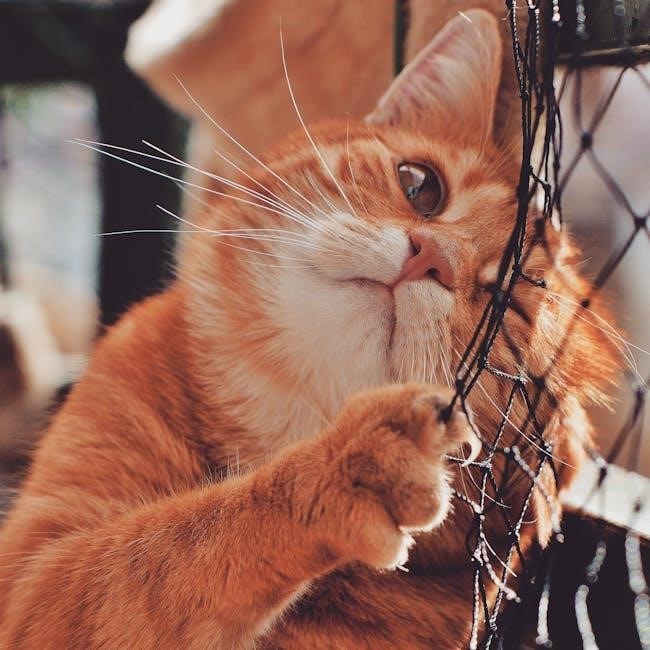
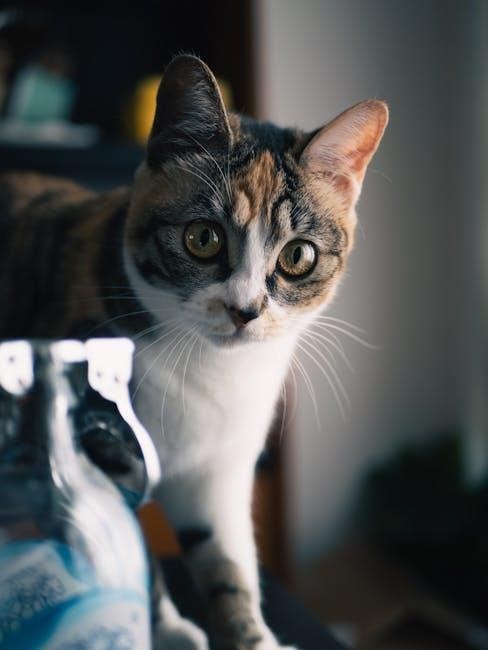
Trazodone Dosage Chart for Cats by Weight
The dosage is determined by the cat’s weight, typically ranging from a specific mg per pound, and can be administered every 12 hours as needed. Always consult a veterinarian for the precise dose to ensure safety and efficacy.
General Dosage Guidelines
Trazodone dosage for cats is typically determined by weight, with a standard range of 50-100 mg per cat, divided as needed. The medication can be administered orally, either as needed for stressful events or up to every 12 hours if prescribed for ongoing anxiety. It’s important to follow a veterinarian’s advice, as the exact dose depends on the cat’s specific needs and health status. Starting with a lower dose and gradually adjusting is often recommended to minimize side effects. Regular monitoring is essential to ensure the medication’s effectiveness and safety. Always consult a vet before initiating or adjusting treatment, especially for long-term use or in cats with underlying health conditions.
Weight-Based Dosage Recommendations
Trazodone dosage for cats is primarily determined by the cat’s weight, with a typical range of 50-100 mg per administration. For cats weighing less than 10 pounds, a starting dose of 25-50 mg is often recommended. Cats between 10-20 pounds may receive 50 mg, while those over 20 pounds could be prescribed up to 100 mg. The dosage should be tailored to the individual cat’s needs, as factors like overall health and anxiety severity play a role. Veterinarians may adjust doses to ensure safety and efficacy, so it’s crucial to follow their guidance. Regular monitoring is essential to avoid adverse effects and maintain therapeutic benefits.
Maximum and Minimum Dosages
The maximum dosage of trazodone for cats is typically 100 mg per administration, while the minimum is around 25 mg. Dosage limits are set to ensure safety and efficacy, with adjustments based on the cat’s weight and condition. For cats weighing less than 10 pounds, the minimum dose is often 25 mg, increasing for heavier cats. The maximum dose of 100 mg is generally reserved for cats over 20 pounds. Factors like the severity of anxiety and the cat’s overall health also influence these limits. Veterinarians may adjust dosages to prevent side effects, ensuring the medication remains safe and effective. Always consult a vet to determine the appropriate range for your cat.
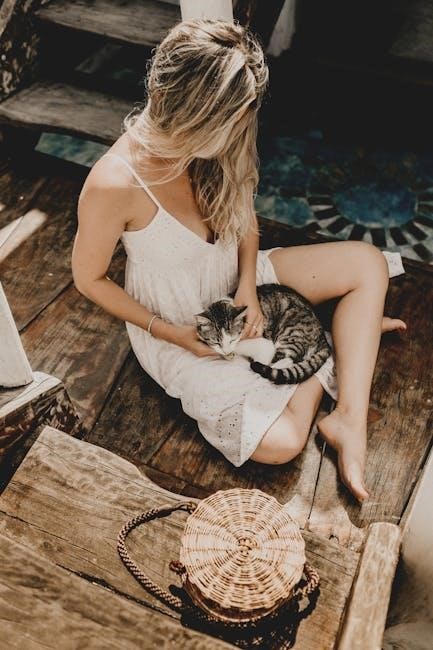
Understanding the Dosage Chart
The dosage chart provides a weight-based guide for trazodone administration in cats, ensuring safe and effective use. It helps determine the appropriate dose based on the cat’s weight, ranging from 25 mg to 100 mg, typically given every 12 hours. Consulting a veterinarian is essential for accurate interpretation and proper usage.
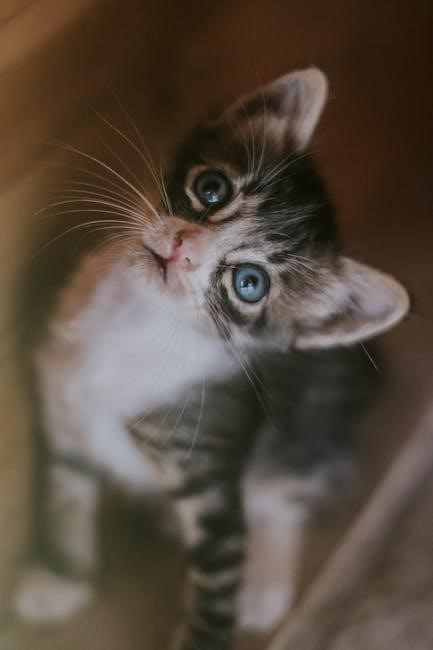
How to Read the Chart
The dosage chart organizes information by the cat’s weight, providing clear guidelines for administering trazodone. Columns typically include the cat’s weight range, recommended dosage, and frequency of administration. Each entry specifies the appropriate dose in milligrams, ensuring accuracy. The chart may also include notes on maximum and minimum dosages to avoid overmedication or undermedication. By matching the cat’s weight to the corresponding dosage, owners can safely administer the medication. Always consult the chart alongside veterinary advice to tailor the dose to the cat’s specific needs and health conditions. This ensures the medication’s effectiveness and safety, particularly for cats with pre-existing medical conditions or those requiring long-term use.

Factors Influencing Dosage
Several factors influence the appropriate dosage of trazodone for cats, primarily their weight, health status, and the severity of anxiety or stress. The cat’s weight is the most critical factor, as dosages are typically prescribed per pound to ensure safety. Other considerations include pre-existing medical conditions, such as kidney or liver disease, which may require dose adjustments. The frequency of administration, usually every 12 hours, depends on the situation’s intensity, like travel or vet visits. Additionally, interactions with other medications or supplements must be evaluated. A veterinarian’s expertise is essential to tailor the dose to the cat’s unique needs, ensuring effectiveness while minimizing risks. Regular monitoring may also influence dosage changes over time.
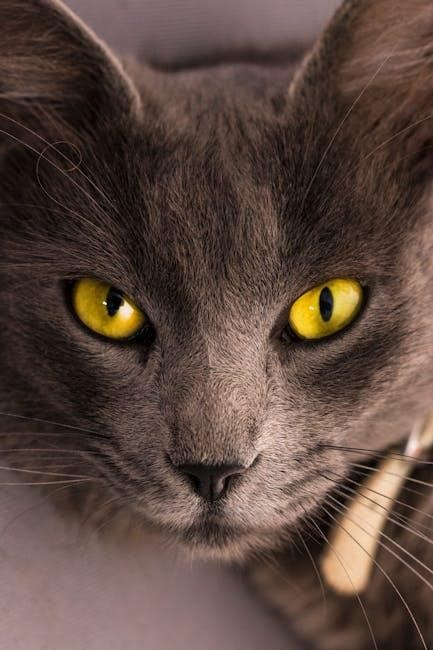
Risks and Side Effects of Trazodone in Cats
Trazodone can cause side effects in cats, including drowsiness, lethargy, and changes in appetite. Monitoring for severe reactions like vomiting or disorientation is crucial for safety.
Common Side Effects
While generally safe, trazodone can cause mild to moderate side effects in cats. Common side effects include sedation, lethargy, and changes in appetite. Some cats may experience gastrointestinal issues such as nausea or vomiting. In rare cases, dizziness or disorientation can occur. These side effects are typically short-lived and resolve on their own. However, it’s important to monitor your cat’s behavior and physical condition closely after administration. If side effects persist or worsen, consult your veterinarian promptly. Ensuring the correct dosage based on your cat’s weight can help minimize the risk of adverse effects. Always follow veterinary advice to ensure your cat’s safety and well-being.
Severe Side Effects to Watch For
While rare, severe side effects of trazodone in cats require immediate veterinary attention. These may include difficulty breathing, rapid heart rate, or seizures. In some cases, cats may exhibit extreme lethargy or unresponsiveness. Agitation, confusion, or unusual behavior can also indicate a severe reaction. If your cat experiences any of these symptoms, contact your veterinarian right away. Severe side effects are often linked to overdosing or individual sensitivity to the medication. Monitoring your cat’s behavior and physical condition after administering trazodone is crucial. Always adhere to the prescribed dosage to minimize risks. If severe side effects occur, seek emergency veterinary care to ensure your cat’s safety and well-being.
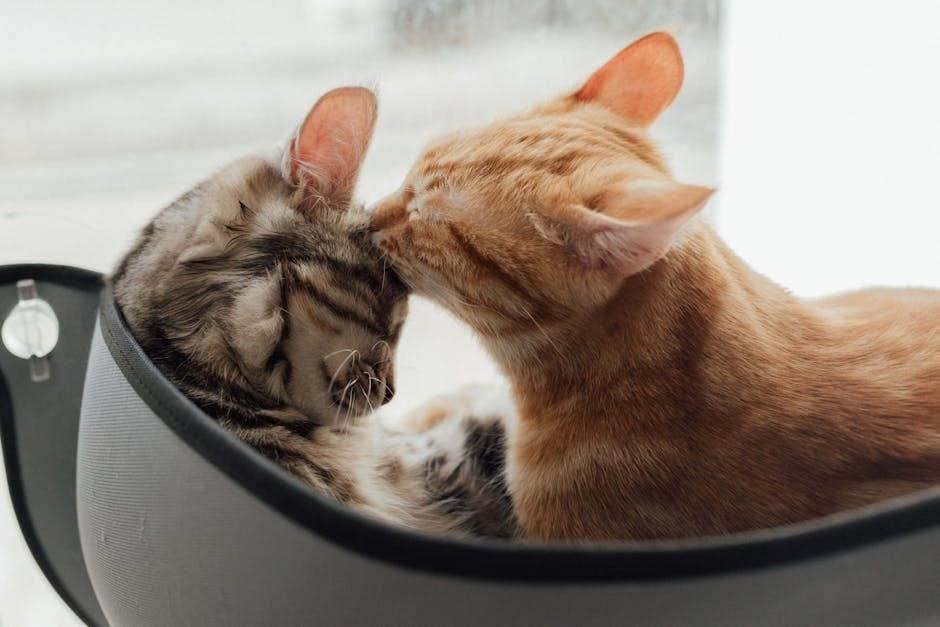
Administering Trazodone to Cats
Trazodone is typically administered orally to cats, often with food to reduce stomach upset. It is commonly given before stressful events or as prescribed by a veterinarian.
Best Practices for Giving Trazodone
Administering trazodone to cats requires careful attention to dosage and timing. Always consult a veterinarian to confirm the correct dose based on your cat’s weight and condition. Trazodone should be given orally, ideally with food to minimize stomach upset. For stress-related situations, such as vet visits or travel, administer the medication 1-2 hours beforehand for optimal effect. Use a accurate scale to ensure the correct weight-based dose, and avoid splitting tablets unless advised by your vet. Consider using a pill pocket or treat to make administration less stressful. Never exceed the recommended dose or frequency without veterinary guidance to prevent potential side effects. Consistency and adherence to veterinary instructions are key for safe and effective use.
Tips for Stress-Free Administration
To ensure a stress-free experience when administering trazodone to your cat, consider the following tips. Use pill pockets or treats to disguise the medication, making it more appealing for your cat to take. Approach your cat calmly and gently, avoiding sudden movements that might cause alarm. Administer the medication in a quiet, comfortable environment to minimize anxiety. Timing is crucial—give the dose 1-2 hours before a stressful event, such as a vet visit, for optimal effectiveness. If your cat is particularly resistant, consult your veterinarian about alternative administration methods, such as compounding the medication into a flavored liquid. Patience and consistency are key to making the process smooth and stress-free for both you and your cat.

Consulting a Veterinarian
Consulting a veterinarian is crucial for ensuring proper trazodone dosage and administration tailored to your cat’s specific needs, health status, and weight, avoiding potential risks and side effects.
Why Veterinary Guidance is Essential
Veterinary guidance is essential when using trazodone for cats to ensure safe and effective treatment. A vet will assess your cat’s overall health, weight, and specific needs to determine the correct dosage, minimizing risks of side effects or toxicity. Incorrect dosing can lead to adverse reactions or reduced efficacy. Factors such as pre-existing medical conditions, other medications, and the underlying cause of anxiety or stress are considered. Vets also ensure the formulation and administration method are appropriate for your cat. Without professional advice, pet owners may inadvertently harm their cat or fail to address the underlying issue effectively. Always consult a veterinarian before administering trazodone to your cat.
How to Discuss Trazodone with Your Vet
When discussing trazodone with your vet, ask about the appropriate dosage for your cat based on their weight and specific needs. Inquire about potential side effects and how to monitor for them. Discuss the underlying cause of your cat’s anxiety or stress to ensure trazodone is the best option. Provide details about your cat’s medical history, including any prior medications or health conditions. Ask for guidance on administration, such as timing and how to give the medication effectively. Also, seek advice on how to gradually discontinue use if needed. Your vet can tailor recommendations to your cat’s unique situation, ensuring safe and effective treatment. Open communication will help address concerns and ensure the best outcome for your cat.
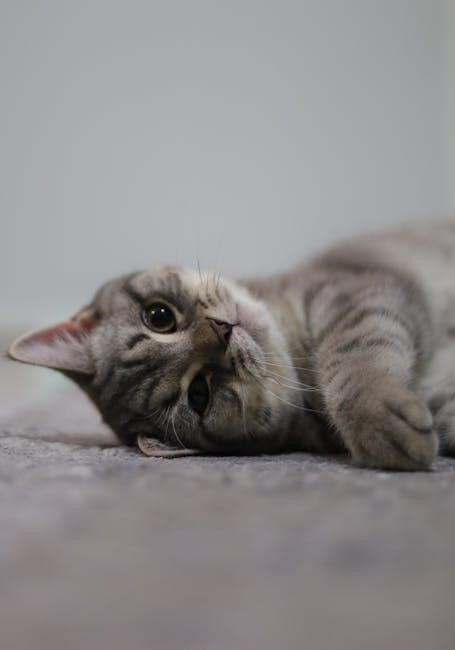
Leave a Reply
You must be logged in to post a comment.